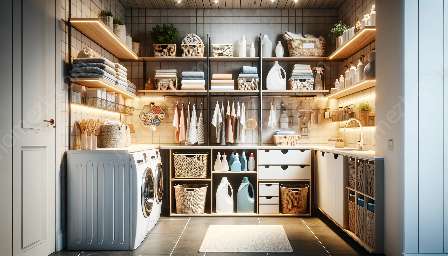In a modern household, the laundry room is an essential space that requires careful design and organization to maximize efficiency. Utility sinks and countertops play a crucial role in enhancing the functionality and aesthetics of laundry rooms. This comprehensive guide will delve into the key considerations for choosing utility sinks and countertops, their compatibility with laundry room storage, and their impact on home storage & shelving.
Understanding the Importance of Utility Sinks and Countertops
Laundry rooms often serve as multi-functional spaces, accommodating various tasks such as washing, drying, ironing, and storage. Utility sinks and countertops are integral components that can significantly improve the productivity and versatility of this area. An ideal utility sink provides a dedicated area for handwashing delicates, soaking stained items, and cleaning mops or other large items, reducing the burden on the main kitchen sink. Moreover, countertops offer a convenient surface for folding clothes, organizing laundry essentials, and even performing additional tasks such as crafting or sewing, transforming the laundry room into a versatile workspace.
Choosing the Right Utility Sink and Countertop
When selecting a utility sink, it's essential to consider the available space, intended usage, and overall design aesthetic. Deep, durable stainless steel or composite material sinks are popular choices for their durability, ease of maintenance, and resistance to stains and scratches. The size of the sink should accommodate the laundry room's needs without overwhelming the space. Additionally, the integration of accessories such as built-in washboards, drying racks, and detachable spray heads can enhance the sink's functionality.
Countertops should complement the sink and provide ample workspace without sacrificing valuable floor space. Materials such as quartz, laminate, or stainless steel offer practicality and visual appeal, making them suitable for a variety of laundry room designs. The incorporation of built-in storage options, such as drawers, shelves, or cabinets, can further optimize the utility of the countertop while promoting organization and accessibility of laundry supplies.
Enhancing Laundry Room Storage with Utility Sinks and Countertops
Integrating utility sinks and countertops into the laundry room design is an effective strategy for maximizing storage space. Cabinets and shelves can be installed above or below the countertop, providing designated areas for storing detergents, fabric softeners, cleaning supplies, and other laundry essentials. Hanging rods or hooks can be mounted near the sink or countertop to accommodate drying racks, hangers, and even bulkier items such as ironing boards.
Furthermore, the addition of pull-out baskets, drying racks, or a dedicated ironing board cabinet can optimize the available space and streamline the laundry routine. By strategically positioning the sink and countertop, homeowners can create an efficient, organized environment that enhances the functionality of the laundry room while minimizing clutter.
Compatibility with Home Storage & Shelving
Utility sinks and countertops can seamlessly integrate with broader home storage and shelving solutions. In homes with limited storage space, the laundry room often serves as a secondary storage area for seasonal items, cleaning supplies, and household tools. The inclusion of utility sinks and countertops that feature versatile storage options enhances the overall organization of the home.
Homeowners can coordinate the design and materials of utility sinks and countertops with existing home storage and shelving units to create a cohesive aesthetic throughout the living space. This cohesive approach promotes a sense of continuity and functionality, ensuring that the laundry room not only meets its practical demands but also contributes to the overall visual appeal and efficiency of the home's storage solutions.
Conclusion
Utility sinks and countertops are indispensable elements of a well-designed laundry room. By carefully selecting the right sink and countertop, maximizing their integration with laundry room storage, and considering their impact on home storage and shelving, homeowners can transform their laundry spaces into organized, efficient, and visually appealing areas that complement the overall functionality and design of their homes.


